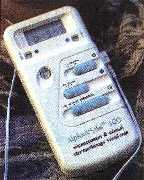Published in The Herald (Everett, Washington), Health section, November 6, 2001:
ZAPPING PAIN John Doremus of Everett reads while wearing an Alpha-Stim 100 to control his chronic pain from
arthritis and a diabetic condition. Stephanie S. Cordle
By Christina Harper
Clips are attached to the ear lobes (left), and the unit (far right) provides a microcurrent that passes through the body and brain. The device can be obtained
only with a doctor’s prescription.
The Herald



|
John Doremus of Everett had been putting up with lots of pain and taking medications for 10 years while suffering from diabetic neuropathy, a condition that
leads to numbing pain in his hands and legs. He also has rheumatoid arthritis.
Doremus, 57, now uses a microcurrent and cranial electrotherapy stimulator,
which moves electrons through the body and brain. It’s called an Alpha-Stim 100.
The device can be obtained only with a doctor’s prescription and is covered by
some insurance companies. It is noninvasive, since patients attach two clips to the earlobes. Patients can use the device several times a day for 10 to 20 minutes a session for pain, anxiety, and depression.
“Dosage is very individual to the patient, especially with chronic pain,” said Nancy Campbell, manager of Therapeutic Resources in Mill Creek.
“It’s nothing new,” Campbell said.
The technology is 20 years old and research on the ear clips has been going on for about 30 years.
For an hour a day, depending on his pain, Doremus hooks up the Alpha-Stim to
his earlobes, turns the unit on and relaxes.
Researchers don’t know exactly how the electrical pulses affect the brain, but
they do know that it helps some patients. Doremus says the cumulative results have helped him.
After three to four weeks of using the device, Doremus began using the unit
during the day and was down to taking one pain pill at night. Soon he tapered off the pain medication altogether.
The $800 cost for the machine was more economical than $90 a month for pain
medication, Doremus said, though his insurance did cover the cost.
He learned through experience the best time to use the Alpha-Stim. The rhythm of the pulses may affect him during some activities.
“It’s better not to use it driving,” Doremus said.
Doremus knows that his ailments can be better or worse depending sometimes on
the weather. But in the year that he has been using the Alpha-Stim, he has been more than pleased with the results.
“It doesn’t cure the pain but dulls it out,” Doremus said. “It’s pain I can deal with
now.”